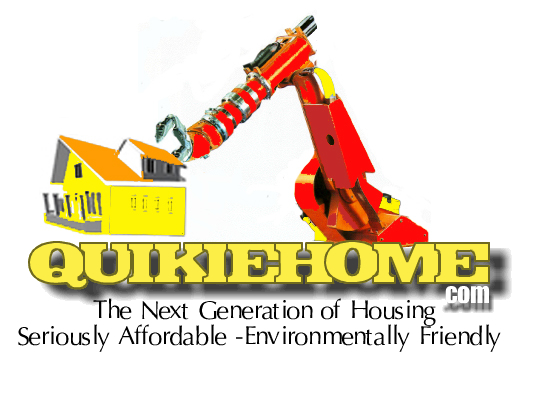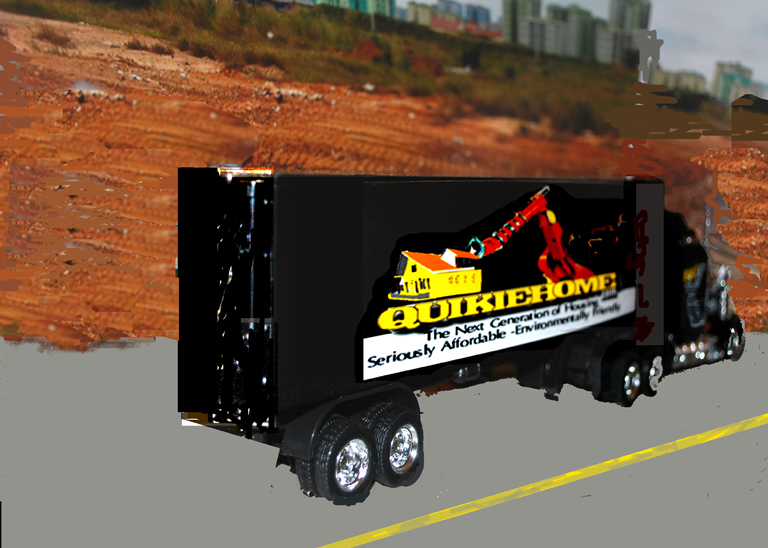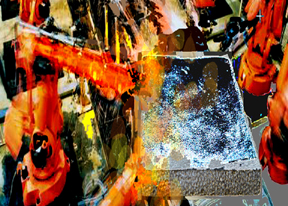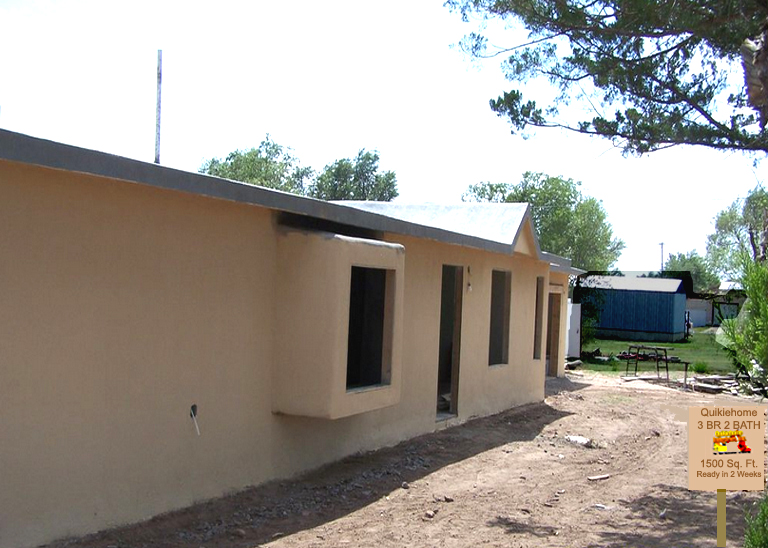



This is an
overview business plan. It does not imply an offering of Securities. The content
contains CONFIDENTIAL, PROPRIETARY & TRADE SECRET INFORMATION provided
to encourage interest and may not be disclosed in whole or in part for public
use without prior written consent. The content may be reviewed and used by
any recognized media organization .
“QUIKIEHOME” produces a residential structure to deal with
environmental risks such as hurricanes, tornadoes, floods and fire. These
disasters require damaged structures to be rebuilt in large numbers rapidly,
efficiently, and economically. They suggest the need for alternatives to
existing construction methods that can withstand recurring environmental risks
and hazards. This encourages the development of a new type of construction
method to satisfy all such requirements. The States of Louisiana, Alabama, And
Mississippi are in need of an immediate solution related to the extensive
residential flood damage caused by the recent weather disaster. With a limited
time-frame for providing suitable replacement housing, during which the existing
damaged residential structures contaminated by water damage and mold must be
removed before any replacement construction is possible, the portion of the
population now suffering from lack of suitable housing will be faced with the
extensive challenge of both survival and interaction with the necessary
financial burdens and rebuilding.
Although some may have availed themselves of suitable private or public sector
insurance, provided they continued to renew the premiums, which may or may not
provide the necessary financial benefits contemplated, the availability of
construction materials, licensed tradespersons, and replacement structures
rebuilt in keeping with necessary building codes represents a substantial
burden. Developments in construction techniques, particularly those taking
advantage of non-traditional materials and application of “next generation”
technology could represent a methodology for drastically shortening the
rebuilding process and lessening the replacement cost factors and the burden on
those in need.
By using the “on-site” advantage to deliver this building method, there are a
number of significant advantages over conventional methods:
• Efficient, Scalable Production: Innovative hybrid field / factory production
system can be deployed rapidly in damage-troubled areas to provide the
capability to efficiently scale production across a broad range from single
structures to large groups in a development configuration.
• Rapid Build: The mobile production capability, factory automation contained in
an over-the-road or rail platform, and advanced supply chain management provide
for control of both construction lead times and completion times measured in
weeks rather than months.
• Economical: The structures are cost-competitive with conventional
(stick-build) systems. factory production of interior modules containing kitchen
and bathroom elements components provides additional efficiencies, lowering
costs while maintaining higher quality.
• Customizable: The hybrid build system can efficiently be utilized to produce
single-family homes, apartment buildings, and commercial structures with
exterior shell and interior components customized to match local cosmetic design
needs.
• Quality Assured: Integration of quality management and assurance is fully
integrated into the
production system to meet ASTM, ACI, and ISO quality management standards
• Reduced Environmental Risk: The structures resist environmental risks from
hurricanes, tornadoes, fires, floods, and insect infestation
• Lower Cost of Insurance Claims and Ownership: The combination of a durable
structured exterior shell with engineered interior components delivers greatly
reduced maintenance and ownership costs.
• Energy Efficient: Superior thermal characteristics, and high thermal mass,
stabilizes interior temperatures and dramatically reduces heating and cooling
costs.
• Lower Insurance Costs: in certain areas, in contrast to stick built homes, the
reduction in risk from environmental disaster suggests establishing specialized
insurance programs that will reduce homeowner premiums.
Guided by the precepts that resource conservation during design and
construction; the conservation of resources during operations; and protection of
occupants’ health, well being, and productivity should be the resultant, the
concept identifier “QUIKIEHOME” develops high-performance, energy-efficient
structures that provide affordable occupant comfort and well-being while
minimizing environmental impacts and reduced the operating costs associated with
electricity, heating fuel, and water. It encourages local, State, and Federal
government entities to consider it as an alternate solution to overcome home
replacement for population members displaced by flooding which is fundamentally
better building to resist any subsequent flooding. The comfortable, efficient,
appealing design is also ultimately more profitable to construct due to the
application of technology.
“Next Generation” technical developments have enabled the “on-site” construction
of approximately 1500 square foot individual residential housing units
incorporating supplemental solar power (photovoltaic) system, LED lighting
alternative to incandescent, rainwater accumulator serving a hydroponic
vegetable growing capability, and other sustainable “greening” aspects making
the structure extremely efficient and deliver lower energy and water utility
costs then their conventional counterparts.
The use of more durable material results in reduced replacement cost and
provides additional life-cycle financial benefits. The evidence developed from
construction of the initial prototype and a subsequent production model version
confirmed the structure’s unique ability to withstand substantial wind loading
and subsequent flooding. With extremely low energy cost of operation and HAVAC
coefficient making it a beneficial heating and cooling housing solution, it
offers the ability to drastically shorten the time to reestablish communities
and benefit those displaced. Using a combination of plastic and concrete
substrates to produce a structural shell, “QUIKIEHOME” produced in an
“over-the-road” “by-rail” transportable platform containing a proprietary system
for producing the complete residential shell from interlocking panels in an
average fourteen (14) days, “QUIKIEHOME” construction employs unskilled labor
drawn from the displaced population, providing both the return to housing
normalcy and a financially supportive labor revenue stream. The resulting
residential structure is attached to the existing foundation after “scraping”
removal of the original structure, makings use of the existing utility
connectivity in the foundation, and incorporates substantial advantages which
overcome subsequent flooding.
Using placement of operational modules for kitchen and bathroom services within
the structure and conventional interior finishing for floor, walls and ceilings
completes the construction process. Evidence of its viability to withstand a
repeat of the current cause of destruction is easily confirmed. The primary
prototype model and subsequent completion of the production model, and their
proven resistance to the effects of damage caused by “Mother Nature”
substantiates the viability of the constructive process. Cosmetic aspects which
render components with inclusive brick, siding, stucco, and other appearance
aspects cast into modules during the constructive process or applied in the
post-finishing phase to suit make the “QUIKIEHOME” solution compatible with
other affordable community approaches.
EXECUTIVE SUMMARY
IMPLICATIONS OF THE CONCEPT
While the Company initially concentrated on development of an awareness
component for the delivery of a “next generation” methodology of generating “on
site” replacement residential and commercial housing structures as an
alternative to “stick built” construction after major disasters, the design of
an upscale consumer version, the applications for the patented frame and
structural components, and the continuing need for availability suggests a
broader concept. The conceptual “QUIKIEHOME-MAKER”, a portable factory which is
sourced by volumetric mixers and processed to produce the shell of a 1500 square
foot residential structure in fourteen days or less allows for a wide variety of
alternative business models far in excess of simply replacement housing.
The production capability to construct the necessary components was developed
over a five year period. The initial design confirmed the ability of the
technique to produce a range of components which delivered suitable structural
and cosmetic aspects. The production version, deliberately placed in a
geographic location prone to destructive weather forces incorporated enhanced
design aspects. With models at two selected sites in Texas confirming the
production methodology delivers the expected results, the final step in the
ability to deliver the construction technique “on site” was applied to housing
the necessary equipment in a portable platform. Development of the internal
equipment and the transport platform which could be moved over-the-road or by
rail finalized the ability to begin discussions for the final step, a mass
production relationship with agencies and individuals necessary to reach the
goal of a project oriented capability.
The critical path in any activity utilizing “new” technology is to gain the
support of experts in the field who can attest to what has been developed and
how it can best be implemented. The second production version withstood the full
fury of “Mother Nature” and was virtually undamaged despite the total
destruction of surrounding communities. This provided an actuality for having
the production result evaluated.
With the original business model clearly defined, together with basic framework
of a production model with modified structural versions replacing any potential
shortfalls identified in the first model, an approach was made to have the
production model evaluated within the scope of those evaluating necessary
elements related to disaster relief. Although it was expected that the concept
would gain interest among those who face substantial disaster situations, the
substantial revenue stream possibilities were most likely to develop from
disaster agency relief efforts requiring short time frame living accommodations
and longer term housing replacement.
The opportunity to present the concept to those involved in disaster relief to
confirm the viability of the construction technique resulted in clear support
SEE TECHNICAL APPRAISAL CONTAINED IN THIS CONFIDENTIAL REPORT
Housed in a dual-mode aerodynamic over the road trailer design, the
“QUIKIEHOME-MAKER” housing technology “factory” is EPA Smartway Approved. It
provides the flexibility of highway transportation movement with the efficiency
of rail using a changeable-“footprint” function. It delivers the ongoing process
capability to consistently produce defect free material (zero defect target),
and parts to complete 1500 square foot residential shells “on site” in 14 days
at a below $50,000USD cost factor. The proprietary process and equipment
(machinery, tools, fixtures, etc.) yield components with fit, form and function
that ensure a quality resultant.
The economy of scale for constructing the shell is solely dependent upon the
overall cost of the non-hazardous component materials when applied to an
individual unit. The advantages of a predicable labor cost to create the fully
extruded structure and the extremely short personnel training period to assemble
the structure hardly creates a per unit cost variation Adequate gauges and
measuring/testing equipment for process control are included.
Each produced unit is delivered to meet “standard” specifications as identified
in the completion contract. Variations developed from customer option selection
are included. Basic contract terms stipulate:
a) Structure Capacity (in square footage)
b) Capability to meet specifications
c) Revision level of drawings / specifications
d) Delivery Timing Requirements
e) Structure Cost
The “QUIKIEHOME” concept provides a vast advantage to those facing long delays
in finding a solution to flooding while temporarily residing in
locally-available housing or in temporary structures provided by disaster relief
agencies. Benefits also are derived by communities, which can shorten the effect
of displaced population members.
The community benefits from “QUIKIEHOME” affordable housing because it is a
dynamic solution which contributes to maintaining a reason to remain in the
area.
providing direct economic benefits to the local community, including available
work, an increased demand for goods and services which in turn provides
increased local employment opportunities
promoting the lowering of housing costs to accommodate affordable meeting of
education, health costs, and family values.
Encouraging the participation of those from the local community to enhance their
skill base to meet the needs of community rebuilding efforts.
Provides a means of encouraging displaced residents to remain in areas which
house their personal support networks.
Offer significant financial incentives to create subsequent mixed-type
development and joint ventures to further increase post-disaster population
rebuilding.
“QUIKIEHOME” has employed the consulting services of the nonprofit Emerging
Growth Institute to develop awareness of this potential solution to disaster
recovery construction concerns. It has reviewed the credentials of the
Management Team, evaluated the existing prototype and production models,
conducted interviews with personnel, and confirmed component product viability
claims.
Ronald Bell – Director of Construction. Ron Bell has more than 30 years
experience in the manufacturing and construction of residential and commercial
structures and is expert in the application of pre-produced SCIP panels. He has
been a Plant Engineer, an Industrial Engineer, a construction sales manager, and
a Welding and Fabrication Manager.
info@quikiehome.com







